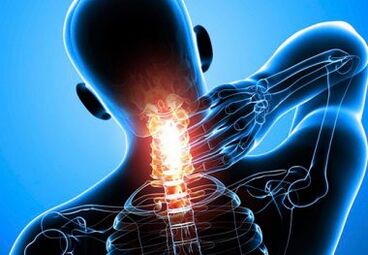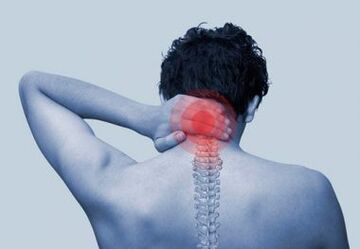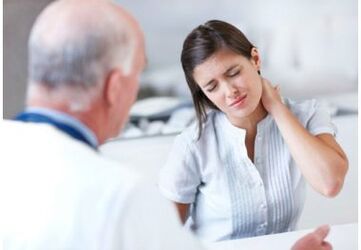Symptoms of cervical osteochondrosis are manifestations of dystrophic changes in cartilage tissue and intervertebral discs. The development of pathology contributes to the decline, deformation of the vertebrae. As a result, patients experience pain, dizziness, nausea.

Osteochondrosis of the cervical spine is accompanied by persistent or recurrent neck pain. This is the most basic symptom of cervical osteochondrosis.
The first symptom
The cervical spine contains the main blood vessels that feed the brain. Micro -impulses from major organs and the central nervous system through nerve fibers. The severity of symptoms depends on the stage of the disease, individual characteristics. With cervical osteochondrosis, the discs that perform the amortization function are negatively affected:
- The structure changed.
- The growth is formed in the form of a peak due to the growth of bone tissue in osteochondrosis. As a result, blood supply declines, nerve fibers do not function.
The first symptoms of the disease are not expressed.

With the further development of osteochondrosis arising in the neck, intense pain is observed - the main symptom. During movement, discomfort increases, muscle tension occurs.
Various categories of people at risk. This process is determined by the factors that provoke the development of cervical osteochondrosis:
- inactive lifestyle;
- overweight;
- concomitant pathology - scoliosis, rheumatism;
- excessive physical activity;
- spinal cord injury.
The main symptoms are in the late stages of development of neck osteochondrosis
Changes in cartilage tissue are manifested in the form of signs, the severity of which depends on the severity of dystrophic disorders. Processes can cause damage to the body's internal systems:
- Compression of nerve endings is characterized by symptoms in the form of osteochondrosis neuralgia. When the spinal cord is pinched, neurological disease can occur. Bone growth that forms at the nerve roots partially or completely paralyzes the vertebrae, causing their cohesion. Loss of sensitivity was observed.
- Squeezing the main and peripheral blood vessels is the cause of lack of adequate blood circulation. Oxygen starvation occurs, heart function worsens. Symptoms of cervical type osteochondrosis: frequent migraines, spikes in blood pressure, coordination disorders, vascular dystonia, dysfunction of the respiratory system. There may be problems with hearing, vision.
External manifestations of cervical osteochondrosis
External symptoms are characterized by a variety of damage to the body. Patients did not complain of deterioration of general well -being at first -degree pathology. To prevent the onset of disease, it is recommended to lead an active lifestyle, go swimming, and do exercise that improves health.

Sensation in the second phase of cervical osteochondrosis is characterized by a pain syndrome, which causes stiffness of movement.
Feelings of discomfort can be localized in different areas of the spine. Patient performance decreased. Arterial compression causes a general weakness, migraine. Tilting, rotation of the head increases discomfort in osteochondrosis.
The third stage of the disease is determined by more obvious symptoms: when pounding the pathological area, there is a sharp pain, immobility, movement is characterized by cracking, dizziness, nausea. This condition is indicated by loss of consciousness, the patient feels a lump in his throat. Violations of blood circulation cause spikes in blood pressure and hypertension. Numbness of the upper limbs occurs.
The fourth phase is determined by the deterioration of conditions. With advanced forms of cervical osteochondrosis, disability of the patient may occur. The main symptom is immobilization of the cervical vertebrae. Compression of arteries and nerve fibers reaches a maximum level, which manifests itself in the form of tinnitus, impaired vision, hearing loss. There are speech disorders - numbness of the tongue, loss of coordination.
Treatment of osteochondrosis localized in the neck area is performed using conservative methods of therapy using medication.
Doctors prescribe physiotherapy, gymnastics that improves health. To get rid of the pain syndrome while exacerbating the pathology, it is recommended to undergo a restorative massage treatment.
Internal symptoms and manifestations of osteochondrosis of the cervical spine
Internal symptoms characterize changes that occur in the structure of cartilage tissue in osteochondrosis:
- Stage I manifestations of chondrosis. The physiological structure of the ridge is disturbed. The location of the disc between the vertebrae narrows due to lack of fluid. Muscle hypertonicity occurs.
- Stage II osteochondrosis of the neck is determined by thinning of the intervertebral disc, its height decreases, which increases the load on the musculoskeletal system. The result is pain.
- Stage III. Cartilage deformation occurs, bone tissue proliferation is observed, intervertebral hernia is formed, protrusion occurs. The case of a falling disc was recorded. The symptoms of the condition are characterized by severity. Arthrosis begins to develop.
- Stage IV. Complete disc destruction is located between the vertebrae with the replacement of further voids with bone or connective tissue. This process leads to the formation of accumulations.

To prevent the development of the disease, it is recommended to do regular exercise at home, aimed at strengthening the muscular corset with osteochondrosis. To relieve pain, special medications, ointments, and injections are prescribed. Folk remedies are used in the form of compresses, bandages.
Are the symptoms different between women and men?
The neck is the most mobile part of the musculoskeletal system, it has 7 vertebrae. The division begins with the pectoralis and attaches to the skull. The signs of cervical osteochondrosis in women do not differ from the pathological manifestations in men. According to statistics, women are more susceptible to this disease, which is due to the anatomical structure, the possibility of pregnancy.
The course of the disease depends on the corresponding conditions, hormone levels, symptoms and other factors.
| The difference | Man | Women |
| Cross section of the spine | Larger size. | Smaller. |
| System functions | The body experiences constant stress. Fractures are less frequent because of more advanced muscles. | It adapts to loads better. Osteochondrosis, curvature in the form of scoliosis, osteoporosis are often diagnosed. |
| Clinical picture | This situation is characterized by stability. Lower pain threshold. The patient is unable to describe all the signs clearly. | Symptoms are pronounced. The patient stated the complaint clearly. |
| Time has changed | This body is not subject to internal system restructuring until 45-50 years. | Changes are observed as a result of pregnancy, hormonal changes after 45. Pain, numbness of the hands may occur. |
Carrying a fetus may be accompanied by the appearance of symptoms:
- development of cervical, lumbar osteochondrosis;
- pinching the nerve endings;
- the occurrence of problems with the cardiovascular system;
- stiffness of movement.
Be sure to watch excerpts from popular health plans. This issue lists in detail all the main symptoms of cervical osteochondrosis:
Diagnostics of osteochondrosis of the cervical spine
A comprehensive diagnosis of osteochondrosis arising in the neck area, taking into account the degree of the disease, the symptoms, is the key to a good condition. To determine an accurate diagnosis, various methods are used:
- Inspection. After seeing a doctor, a visual assessment is performed using parameters - gait, posture. A complete history of the patient's symptoms was taken.
- Radiography is considered an affordable examination method. It is characterized by the possibility of the occurrence of consequences that affect the general well -being of the patient. Images of the cervical spine are taken from the base of the skull to the upper chest. Studies show the condition of the intervertebral disc.
- Tomography. There are two types: computed and magnetic resonance imaging (MRI). In the first case, with the help of special tools, specialists make cuts under the influence of X-rays. The resulting image is displayed on a computer screen, a 3D model is run. The second type of inspection is based on the work of electromagnetic waves. Layer -by -layer pictures of specific parts of the body are taken.

If the symptoms of osteochondrosis in the neck area are characterized by intensive development, you should see a doctor.
Prevention of neck osteochondrosis
For disease prevention, it is recommended to lead an active lifestyle, do regular exercise, and go swimming. With advanced forms of pathology, methods of treatment are prescribed, including taking drugs that relieve pain, normalize the work of internal systems of the body.






















